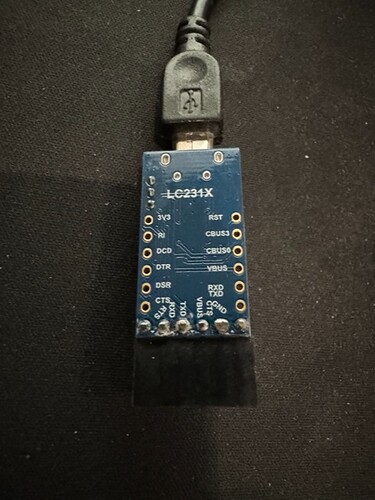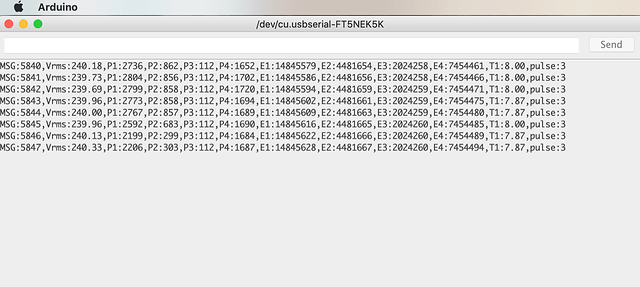I have an Emon system vintage 2016 updated somewhat. 2 tx3 monitoring electrical circuits one using the wifi add on board. Neither near to the pipework I wish to monitor. I also have 2 Emon TH which have not been used for years but could be brought back to life. I hope that the radios would transmit strongly enough for my Pi to pick up. In fact I have just replaced batteries in one of the TH’s and it is working after a fashion. Updates seem only to occur @ every minute even though I have placed it near to the Pi. It is ages since I have done anything with the system and it is working fine monitoring the circuits that I have. Any ideas/suggestions to assist with the temp monitoring would be gratefully received. happy to invest if necessary.
This is expected - it is the default rate for an emonTH (because temperatures aren’t expected to change very rapidly, it extends the battery life).
Your emonTH is probably the cheapest. You should be able to add a pair of external sensors (DS18B20) to attach in good thermal contact to your pipework, and modify the sketch accordingly. You can, if mains is available, supply the emonTH with 5 V d.c. and then speed up the reporting rate if 1 minute is too slow.
One big advantage is this should be fine with your existing OEM setup.
OK Robert thanks once again. You have helped me plenty in the past! Yr answer has provoked more questions I’m afraid.
I have 2 Emon TH of early vintage. The simple thing to do is to run both from a 5v supply and fit an external probe to each.
1 of the Emon TH is working having had new batteries installed. The other I am not so sure about. It has been left for a long time with dead batteries in it. The battery tray is corroded and the neg connection to the board is gone. Otherwise the board looks ok. I don’t think I have a way of testing it until the power supply arrives. I tried a usb uart connector but with no luck. I seem to remember that it won’t power the unit though? Do I need to wait for the 5v supply to arrive to see if it works? Otherwise I will be looking at a new TH although this one shows 868 as frequency or reprogramming the working one to take multiple temp probes. Not sure how they would connect without rj socket?
rgds
Mark Webb
Is all of your system working on 868 MHz? I assume everything must be, but I must ask, because if memory serves, the emonTx V3.2 was around the time we moved to 433 MHz only. If you get a new emonTH, it will be 433 MHz.
You should be able to power and run the emonTH via the UART connector and programmer. I take it you have a programmer? What version is the emonTH? You might need to pull the p.c.b. out of the case to see the version on the underside. I’m guessing either a V1.4 or V1.5, both have 5 V power via USB, the FTDI and the screw terminals.
You connect the two external DS18B20s to the screw terminals. (The terminal block might be missing, in which case it’s easy enough to solder one in. The emonTH has never had an RJ45 connector.)
You did get it the right way round - GND is nearest the centre of the p.c.b. in the V1.4, nearest the centre of the edge in the V1.5?
I’d advise against using two emonTHs because if their transmissions coincide, each will jam the other. It will be a far better solution to feed the two sensors into one emonTH. There are sketches available, and if not it’s easy enough to expand one.
Thanks Robert.
The system is all 868 however it seems that nothing was using it until I put new batteries in the TH. I have 2 TX3. One is communicating via wifi. (You helped me out with that one big time!) The other is right beside the Pi but is connected to the Pi via the uart and usb. Not sure why??. On the other TH it says v1.4.1 node 20. They did work concurrently at one time. The gnd terminal is towards the centre of the board and I made sure the Uart connector was the right way around. I guess it is bust! So now the difficult bit editing the TH script for multiple temp sensors. I am not good at all with GitHub and Arduino on my Mac laptop. I have updated tx3 etc using Uart to the Pi which was simple. But this will be a custom script. Can I pullout what is on the TH edit (with yr help!) and return?
rgds
Mark Webb
No - you need the human-readable source code, and that never reaches the processor in the emonTH (or emonTx).
Is the V1.4.1 and Node 20 the one you want to modify?
Which RFM module does it have - RFM12B or RFM69CW? RFM12B & RFM69CW Wireless Transceiver Modules — OpenEnergyMonitor 0.0.1 documentation
The first thing is to install (or probably update) the Arduino IDE. There are instructions in ‘Docs’ for a Mac, but they are also probably out of date. But they should be a big help: Installing the Arduino IDE – macOS — OpenEnergyMonitor 0.0.1 documentation
When you have this, try connecting the not-working emonTH and see if you see anything via the serial monitor when you plug it in - or possibly when you close and re-open the serial monitor (this forces the emonTH to reset for me - running Linux).
The emonTH won’t necessarily show any signs of working or not working (i.e. a flashing LED).
I won’t modify a sketch until I know which version you are going to use.
Unfortunately, I won’t be able to test the sketch because my emonTH is counting my gas meter pulses.
Arduino installed but I have not been asked or been able to download drivers. The docs you guided me to give a link to drivers but I am forbidden from accessing it.
Radio is rfm12B 868. Not node 20. How do I discover node number of the other TH reporting as Emonth1 I guess that is node 19 according to emonhub config?
rgds
Mark Webb
Apologies Robert I am really not very good at this because I do it so rarely. See previous reply.
I don’t know why - your ISP? Anti-virus software?
I got it from here straight away:
https://www.silabs.com/documents/public/software/Mac_OSX_VCP_Driver.zip
It’s a 2 MB file, so it will take a while to upload it here - but if this link doesn’t work, I’ll upload it here.
If it’s transmitting, look at what’s coming in to emonHub (emonCMS: Setup → EmonHub, View Log (maybe download it - easier to read).
If you know they are Nodes 19 & 20, then the Node ID can be set to either using the on-board physical switch. You’ll need to change the emonHub.conf file anyway to include the 2nd DS18B20.
Yes coming in on node 19.
Board does not have dip switches.
The drivers that you sent. Are they the correct ones for the old usb/uart that I have?
rgds
Mark Webb
I have installed the drivers from the link that you sent. The usb/uart is identified in Arduino as FT5NEK5K although that has not changed since installing drivers and rebooting. Arduino asks for the board type. I have put in Arduino uno. Not sure if that is correct? The serial monitor (baud rate 9600) is not showing anything from the working Emon TH
rgds
Mark Webb
OK, the V1.4 doesn’t have them.
I know almost nothing about Apple Macs, but I believe unless you have the LC321X, there’s only one set of drivers. I assumed you have the Wicked Device or the OEM equivalent programmer.
Correct.
This may well be correct, and not a problem - many sketches only write to the serial output if it’s enabled, and only on power-up. Were you checking as the emonTH powered up?
I’ll see about finding a sketch that looks appropriate, or is a good starting point, and I’ll see what I can do for you. But it might not be for a few days.
So I will need the correct drivers for this.
A way to test the usb/uart would maybe be to plug into Emon tx3 and see if data is being sent?
Thank you for your help so far and with the sketch. I can wait. I will look for drivers.
Rgds
Mark Webb
Following my last email this am.
I have connected the usb/uart to an Emon tx3 and data is being collected in Arduino using installed drivers.
I thought you had an OLD setup. All the information regarding the newer programmer is in the Docs section.
Can you confirm your emonTH V1.4 has the RFµ 328 module?
Do you have, or where can I find a sketch for my Emonth to play with? I guess GitHub but plenty to choose from.
rgds
Mark Webb
I’m working on one for you.
Yes not pressuring you. I just thought I could have a look and see if I can learn to edit and work out what does what.
Try this. I can’t prove it because my emonTH V1.x is in use, but it compiles. If you see a cartload of compiler warnings, you can ignore the ones from JeeLib.
emonTH_markstjwebb.zip (4.8 KB)

